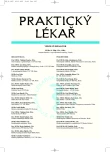The occurrence of heterozygous mutations in the HFE gene in chronic liver diseases
Authors:
J. Stránský 1; Čimburová M.. 2 3; K. Krátká 1,3; M. Hendrichová 1,3; J. Stříteský 4
Authors‘ workplace:
I. interní klinika FNKV a 3. LF UK, Praha
Přednosta: prof. MUDr. Jiří Horák, CSc.
1; ÚBBMB - Oddělení buněčné a molekulární biologie, 3. LF UK, Praha
Vedoucí: Doc. RNDr. Jan Kovář, DrSc.
2; Centrum pro výzkum diabetů, metabolismu a výživy 3. LF UK, Praha
Přednosta: prof. MUDr. Michal Anděl, CSc.
3; Ústav patologie 1. LF UKaVFN, Praha
Přednosta: prof. MUDr. Ctibor Povýšil, DrSc.
4
Published in:
Prakt. Lék. 2007; 87(11): 660-664
Category:
Of different specialties
Overview
Background:
The clinical importance of HFE gene heterozygous mutations in chronic liver disease is not fully understood and various and controversial data have been published on the subject in different parts of the world. The authors examined a total of 135 adult patients and 54 controls for HFE gene heterozygous mutations (C282Y, H63D, S65C). The subgroups of patients comprised of 51 individuals affected by chronic hepatitis B or C, 37 with liver cirrhosis due to chronic HBV or HCV infection and 47 with alcoholic, primary biliary or cryptogenic cirrhosis. The control group was made up of 33 individuals with a liver steatosis confirmed by an ultrasound examination and 21 with a distinct liver disease.
Results:
We found 55 heterozygous mutations of HFE gene (29.1 %) in the 189 patients examined. The most frequent mutations detected were: H63D in 19 %, C282Y in 5.3 %, S65C in 1.6 %, and compound mutation C282Y/H63D in 1.1 %. No statistically significant difference in HFE gene heterozygous mutations was found between the individual groups of patients or when compared to the controls. In mutant patients, the only significant biochemical parameter was a higher serum iron level compared to all non-mutant patients (p=0.018) however, this slight elevation was still within the reference value. No statistically relevant differences were found in the mean values of ferritin, transferrin, iron binding capacity, ALT and AST activity in serum either.
Conclusion:
Heterozygous mutations of the HFE gene are implicated in various chronic liver diseases irrespective of their etiology and mostly, they do not have any fundamental clinical importance. Nevertheless, they may contribute, along with other liver disease risk factors, to the deterioration of the liver disease in some patients.
Key words:
HFE gene mutations (C282Y, H63D, S65C), hepatitis B, C, liver cirrhosis viral, alcoholic, biliary, cryptogenic, chronic liver diseases.
Labels
General practitioner for children and adolescents General practitioner for adultsArticle was published in
General Practitioner

2007 Issue 11
Most read in this issue
- Microangiopathic haemolytic anemia (MAHA) as a main symptom of a generalized tumour
- Acute liver failure due to disulfiram – a case study
- Fibromyalgia
- Mesodiencephalic modulation to ease the symptoms of diabetic neuropathy – a cross-over study
